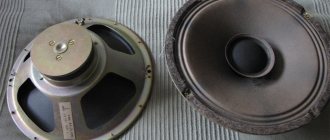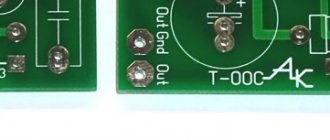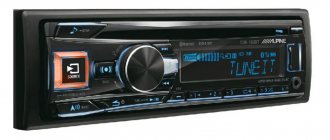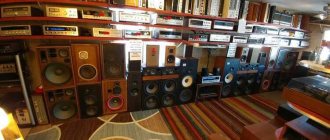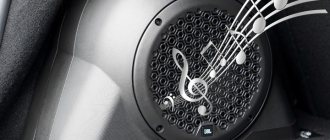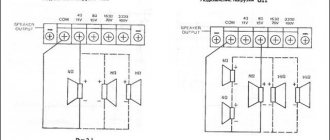What is a tweeter and why is it needed?
A tweeter (from English tweet - twitter, tweet) is a speaker designed for high-quality reproduction of high-frequency sounds in the audible range (2000-20000 Hz). Why is it needed?
Firstly, car manufacturers often skimp on the standard audio system and limit themselves to installing a pair of inexpensive full-range speakers in the doors. “Failure” of high frequencies on such speakers is a common occurrence. The problem can be solved by replacing the standard wideband speakers with coaxial ones, or by installing tweeters in addition to the standard ones.
Secondly, the presence of tweeters is necessary if you value good sound and decide to install component acoustics in your car, i.e., such acoustics in which each frequency band is sounded by a separate speaker: HF - tweeters, MF - full-range speakers, LF - subwoofers . Despite all the promise of coaxial acoustics, component acoustics are still considered the best solution for ensuring purity and sound quality.
Rating of quality car speaker models
Magnum MBM 6.5-4SB (coaxial)
Inexpensive, but good speakers for beginning car audio enthusiasts. Their sound is better than standard ones, and they are easy to install without going to a specialized workshop.
2. Car speakers Ural AK-74.C (two-component speaker system)
A set in an inexpensive price segment with good sound and easy installation in a car door. Having minimal knowledge about car acoustics and a set of tools, installing speakers in a car is not difficult.
This is an excellent choice for those who do not want to deal with the purchase of amplifiers and complex installation. The acoustics play from the base unit; the kit includes all the necessary components for installation.
3. Car speakers Pioneer TS-1339R (coaxial)
Budget three-way car speakers sound good, but do not have deep bass from the subwoofer. The speakers are adapted by the manufacturer for the Russian market, but installation in standard places is sometimes difficult; the help of specially trained people is required.
4. Car speakers JBL GT7-96 (coaxial)
Oval three-channel speakers for installation in the rear of the car from a reliable manufacturer. Good quality for bass lovers without a subwoofer. The bass is powerful, but does not overwhelm other frequencies. The model is easily mounted into standard sockets.
5. Car speakers Pioneer TS-1639R (coaxial)
Three-way speakers have good bass reproduction. They are distinguished by reliable assembly, interesting appearance, deep, high-quality sound. The quality for the budget segment is simply excellent. High frequencies can be a little annoying for audiophiles.
The model is largely the same as the Pioneer TS-1339R, but the larger speaker size allows it to produce more sound power.
6. Car speakers JBL CS763 (coaxial)
Three-way speakers with pop sound quality, producing loud, high-quality sound. The bass is present in the proper volume, but for those who like “louder and heavier” sounds it may not be enough. Good sound even without an amplifier.
Speakers need time to develop - at first the sound may not be very clear. They have a large installation depth, so their placement is limited.
Hertz DSK 165.3 (component car speakers)
Two-way speakers in the front doors of the car. The tweeters are located where it is most convenient for the driver, especially since they are equipped with special holders. The sound is high quality and natural, but not too loud. The Hertz manufacturer is reliable and proven; there are almost no quality issues.
Car speakers Morel MAXIMO-6 (component)
The speakers are reliably built and of good quality, with a rich bass component, and have overload protection. These acoustics are no longer just “a little better than standard”, this is in its own way the next level of quality, because Morel is one of the best manufacturers of car audio.
Any model guarantees excellent quality, regardless of the price segment. The set includes four speakers - two tweeters and two midbass.
Pioneer TS-R1750S (coaxial)
Models of the Pioneer brand are budget-friendly and have good quality; they can replace the standard acoustics with higher-quality ones. Music playback is clear and loud.
10. Professional speakers Audison Prima APK 165 (component)
The model is an example of good, expensive two-way acoustics for a car. It doesn't just improve sound quality by replacing standard speakers. This is a fundamental leap in sound quality. The speakers produce powerful, clear sound, although the presence of an amplifier is highly desirable.
The Audison brand itself is quite expensive, but at the same time it is well-known and reliable in the world of car acoustics. If the price doesn’t deter you, and the sound of music primarily values detail, not “bass,” then this is the best choice!
All these models have proven themselves well in the market and were on a sales wave in 2019.
Video about speakers:
Installation and connection of tweeters.
Before you start choosing a tweeter model, it would be useful to decide on where to install them. Installing tweeters has several features that should not be forgotten so as not to be disappointed in their purchase:
Based on the listed requirements, the most suitable places for installing tweeters are doors, mirror corners, dashboard, and side pillars.
Connecting a tweeter also has its own characteristics - tweeters do not like it when a low-frequency signal is supplied to them, especially a low-frequency signal with a large amplitude. If you connect the tweeters not to the amplifier's low-frequency crossover, but to the wideband output of the radio, then the tweeter can quickly fail.
Therefore, most tweeters are equipped with a simple crossover - an ordinary capacitor that filters low-frequency vibrations quite effectively. As a rule, such a capacitor is included in the package of the tweeter itself and is either already soldered to the terminal or to the mounting wires with which the tweeters should be connected to the amplifier (radio tape recorder). Before connecting tweeters, make sure that a capacitor is present in the circuit of each tweeter, otherwise the very first turn on of the acoustics may be the last for the tweeters. If there are no capacitors, it doesn’t matter - you can select them using the formula
and solder them to the positive terminals of the tweeter.
Which beepers to buy for your car? Best tweeters, rating, top
What are tweeters used for and why are they called tweeters?
Tweeters are the most interesting in appearance, small but very necessary speakers. It is responsible for reproducing high-frequency sound (starting from 5 - 7 kHz). These are, for example, female vocals and other “subtle” sounds. That's why people called these speakers tweeters. The device emitting sound from tweeters is very small, flexible and lightweight. Only an emitter that meets these qualities will be able to properly reproduce very short wavelengths. This, in fact, is the cornerstone of the quality of all tweeters. It is also very important that a capacitor is installed in the tweeters, since tweeters are very vulnerable when playing mid or low frequencies at high volumes and instantly fail. Naturally, it is necessary to regulate the frequency range they reproduce with a magnetic or external crossover. But a capacitor, which acts as a filter that does not allow the play of mid and low frequencies, must also be present in them, and if you come across a model without a capacitor, be sure to buy more! Moreover, it costs a penny.
So, we mentioned the need for capacitors for tweeters, now let's move on. Let's talk about what types of tweeters there are, and they can be electronic, piezoelectric, capacitor (not to be confused with a capacitor - a frequency filter, which was mentioned earlier!), isodynamic, electrodynamic and several other different types. For cars, in the overwhelming majority, only the latter, that is, electrodynamic ones, are used. The technology of their device is similar to that of an ordinary speaker. The only difference is in size and slightly in the structure of the sound emitter, which here is called not a diffuser, but a membrane and must be very elastic, as mentioned earlier, in order to oscillate faster and still “oscillate” up to 22 thousand Hertz. The tweeter membranes themselves are most often made of silk. Sometimes they are also paper, but this is in the super-budget variants of tweeters. Their bodies are also not very diverse - there is an ordinary body corresponding to the dimensions of the emitter and a longitudinal cone-shaped body, called a horn, which have dimensions slightly increased in length, which in turn allows you to have a more pronounced directivity pattern (the sound goes where it looks tweeter). Actually, in short, that’s probably all about the device. Now let's remember the characteristics required for tweeters.
Which beepers to buy for your car? Best tweeters, rating, top
Here we have a small table of applicants:
Tweeters or tweeters are high-frequency speakers used in speaker systems. The main task of these devices is to reproduce high-frequency sounds.
Tweeters or tweeters for acoustics are usually included in a multi-component system, but they can also be purchased separately. Externally, they are small speakers, but despite this, they are able to significantly improve car sound, adding volume and sonority to it.
The price of beepers for a car starts from 200 rubles and above, depending on the brand and characteristics of the device.
The first thing you need to do when choosing a sound system for a car is to decide on high-quality component acoustics, because only its use guarantees good and rich sound. Be sure to pay attention to the power of the system; it must match the power of the amplifier.
As for which beepers for the car are better, the main thing here is the material from which their domes are made. It can be silk or metal, plastic, paper.
After purchase, it is better to install the tweeters in podiums (which you can make yourself), and soundproof the door.
Install them backwards or forwards - it all depends on the layout of the speaker system. However, keep in mind that it is not worthwhile to install tweeters yourself without certain skills, since this process is quite complex, and when installing devices of this kind, you should take into account the possibility of sound distortion caused by the effect of its reflection.
Criteria for choosing tweeters for a car
Experts do not see much difference between the performance of tweeters with silk and metal domes, since everything depends entirely on the quality with which they are made and on the company supplying them. The only significant difference is the phase equalization disk, which is only available on metal dome tweeters.
For example, among silk tweeters the highest quality and most productive tweeters are Alphard. Their cost is higher than some other devices, but the quality is noticeably better.
From metal tweeters, high-quality sound is produced by Dragster tweeters, the price of which starts from 1,500 rubles.
Features of tweeters - components of tweeters
The basis for the tweeter is a coil, which is located between the core and the magnet. It is tightly attached to a sound-emitting device - a dome-shaped membrane.
The sound emitted by the membrane occurs as follows:
Basically, tweeters come with the following membranes:
The magnets of HF speakers, regardless of whether they are expensive or cheap, are powerful neodymium.
The most common are 2 types of tweeters, which differ in design features:
How to choose the right tweeters
Tweeters are an important component of any car audio system. They are available for purchase at almost every electronics store. When buying these devices, be sure to pay attention to 3 parameters:
Video: what is a crossover and how to choose tweeters.
The use of other parameters in the selection of tweeters is possible, but it is not so important and rather corresponds to the personal wishes and financial capabilities of the car enthusiast, as well as the technical characteristics of the car.
Review and main characteristics of car speakers: rating of the TOP 10 highest quality speakers of 2022 for the car interior. Video about speakers.
Car speakers are offered on the market in huge quantities, it is very difficult to choose good ones, so it is better to choose the “best” ones based on the combination of quality and price. But before presenting the models included in the rating, it is necessary to understand the basic concepts of audio system parameters.
Tweeter characteristics.
Prices for various tweeter models differ tens of times – from a thousand rubles to tens of thousands. Both the brand of the tweeter and its characteristics contribute to the price - you can choose a model to suit any budget, but you should keep in mind that the class of the tweeter must correspond to the class of the other components of the audio system. Just as there is no point in installing expensive tweeters next to simple cheap broadband speakers, there is no point in saving on tweeters in a Hi-End audio system.
The diameter of tweeters varies from 2 to 10 cm, models with high power usually have a larger diameter, but there is no obvious relationship here, and the diameter of the tweeter should be considered as a purely geometric characteristic: a small tweeter, as a rule, has an easier place to find.
Tweeters are highly sensitive - even the cheapest models provide 95 dB. But if the sensitivity of tweeters is greater than the sensitivity of full-range speakers, then the volume of high frequencies will be noticeably greater than the volume of other frequencies. In this case, either the tweeters should be moved further from the listener's ears, or the level of high frequencies on the head unit should be reduced.
impedance or internal resistance must be exactly matched by the amplifier. If you connect a speaker with an impedance of 2 ohms to an output rated for at least 4 ohms, the amplifier's output stage may burn out, unable to withstand twice the current. If, on the contrary, you connect an 8 ohm load to an output designed for a maximum of 4, then the sound of the speaker will be much quieter than if the connection were made correctly.
Tweeters are often connected in parallel to a full-range speaker. It should be remembered that the overall impedance changes! It is calculated using a formula corresponding to the connection type.
When selecting a tweeter, remember that the minimum frequency of the tweeter should be lower than the maximum frequency of the full-range (or mid-range) speaker - this will ensure an even amplitude-frequency response of the entire system.
The maximum tweeter frequency cannot be lower than 20,000 Hz. As a rule, all tweeter models meet this standard. But some have a much higher maximum frequency - 22,000, 30,000 and even 50,000 Hz. What's the point of this? Of course, the human ear cannot hear such frequencies. Such frequencies are rather an indicator of the perfection of the equipment and some guarantee that in the audible region up to 20,000 Hz the frequency response of the tweeter will be as smooth as possible.
Tweeters sold separately
Terminologically, the well-established Russian “pishchalka” sounds less respectful than the foreign tweeter. Because a squeak is a squeak, nothing more, and a tweet is a trill...
Coral MT25 | Audison Prima AP 1 | Kicker KST 254 | Eton CX 260 | Rockford Fosgate T1T-S | DLS Scandinavia 1 | Morel MT-250 | CDT ES-010WD | AD MM1 | Ground Zero GZPT 28SX
Having discovered a pure test of midrange speakers in the last issue, one of our authors (who did not participate in that project) sarcastically asked: “In the next issue, will you test tweeters separately?” To which, of course, I received a proud answer: “We will!” Why not? In practice, composite, heterogeneous acoustic systems are found no less often than homogeneous (or mono-brand, whatever). We allowed HF emitters to participate in this test if they met the only condition: they must be available to the average buyer separately, and not as part of a multi-band system. This is logical, and we are not the only ones who think that this is logical. The latter follows from the fact that some of the tweeters submitted for testing are equipped with their own passive filter - not a crossover connecting the low-pass filter for the midbass and the high-pass filter for the tweeter, but rather a separate high-pass filter, presumably optimized specifically for this head.
The choice of “free-standing” tweeters turned out to be wider than we expected, and there was plenty to choose from. One concern was: how to carry out a subjective, auditory assessment for an individual HF emitter? Include a tweeter as part of a multi-band system? Then it will be difficult to say what she contributed to the sound and what was other components; in general, there are more variables than necessary for a confident answer. In this sense, it was easier with midrange drivers, because their domain is the voice, how it sounds is how they play (plus or minus the low formants of male vocals and overtones of female vocals). What should we do here?
The editor-in-chief brought the solution ready-made, and it must be useful... If you are reading this, it means he didn’t cross it out. Either he didn't notice or he agreed. The main one, drawn by considerations unknown to me, brought a disc from his collection and said: “Listen to the second track.” The second track was Leonard Cohen's "Bird on a Wire" performed by Jennifer Warnes. No, whatever you say, there is a benefit...
Firstly, the disc is recorded absolutely luxuriously. Secondly and most importantly, Warnes performs most of the compositions there with a minimum of accompaniment, consisting of only (or almost only) drums, recorded even more luxuriously. In this recording, recommended as test material, a voice with rich overtones sounds against the backdrop of a physically tangible attack of a snare drum and cymbals and bells literally floating in the air. Thus, there is one less problem. But there were no others.
The instrumental research methodology was self-explanatory. Each subject underwent the procedure for measuring the Till-Small parameters in a stripped-down version: the concept of equivalent volume is applicable to tweeters, but has no practical significance - they have a “take-it-with” acoustic design. We present the recorded impedance curves because they speak volumes: about the resonance frequency, about the presence (and degree) of ferrofluid cooling, which is also damping, about the inductance of the voice coil, the value of which must be known if you plan to design a passive filter.
The second is the frequency response along the axis and at two standard angles; if a filter is attached to the tweeter, then with or without it. Based on the same measurement, we determined the sensitivity of the heads, averaging it in the 2 - 5 kHz band in order to get rid of the influence of the frequency response features at the highest frequencies, which were the subject of special discussion.
Third, the dependence of nonlinear distortions on frequencies above 500 Hz. Generally and separately for the two most important harmonics - the third, which is unpleasant for the ear, and the second, which is much less irritating to the hearing aid. A most curious dependence emerged here. Can I call this the “Kim effect”? It is forbidden? Well, okay, I just asked... It turned out (later I found a theoretical justification for this, but this is later, and therefore not entirely honest): the presence of magnetic fluid in the gap helps to increase the share of the third harmonic in the distortion spectrum. And its absence, on the contrary, leads to its weakening in relation to the second, and in absolute value too. So when manufacturers proudly write about ferrofluid cooling, it should be understood as follows: “we spent money on magnetic fluid so that you don’t burn our tweeter.” And not so that it sounds better, keep in mind.
Summing up the results of the test, we (as in the framework of the previous special project with midrange drivers) give recommendations on the use of this or that tweeter based on the detected characteristics and features, but (as then) we undertake to recommend any of them for this or that application. All participants can trill if the wires are connected correctly...
Choices.
If you have problems choosing where to install the tweeter, choose a smaller model - it will be easier to install. Such a tweeter will cost from 2000 rubles.
If you have assembled a high-power audio system with speaker sensitivity above 95 dB, then choosing the appropriate tweeters for it will not be so difficult, and they will cost from 1000 to 3000 rubles.
Do you want to connect a tweeter to the 4-ohm output of the radio in parallel with a full-range speaker? Take both with an impedance of 8 ohms - the total impedance will be just 4 ohms. Such a tweeter will cost from 1100 rubles.
Source
Video on how to install tweeters
Modern audio equipment reproduces the entire required frequency range. This factor is sufficient to listen to music, but there is no effect of the listener's presence at the concert. Purchasing a horn for your car will correct what was lost and provide high-quality sound. Horn acoustics have a simple design - a small speaker is connected to a horn, which significantly increases the sound volume. But you need to pay special attention to a number of factors - the correct choice of a tweeter from a suitable material, installation features and device connections.
Standard car audio: top 10 options in 2022
We already wrote about car audio once. A little over 6 years have passed - and how things have changed. The possibilities and, most importantly, the number of custom car audio installations are shrinking under the blows of large automakers, like shagreen leather.
Interfering with a standard audio system is fraught from all sides: from loss of warranty - for example, due to replacing two speakers - to the inability to “uproot” the standard “head” that has grown into the electronics.
Having mourned the times of ISO connectors and 1 DIN shafts, into which a new radio was inserted in one movement (and the rest will grow!), Let us remember that professionals are still, by definition, ahead of amateurs. The only question is the budget - and with the right approach, the results can be impressive. On the other hand, it’s not just the budget!
You can arrange joint projects of car audio and automotive industry professionals in any order: by power, number of amplifiers, speakers, or even laudatory epithets in their description. It’s a little difficult to choose, so we’ll arrange them in alphabetical order - by car make.
So, we present to your attention ten, if not the best - here you need to listen! - these are the most promising modern “factory” car audio systems in terms of the brightness of impressions. Including price-quality ratio.
Types of car speakers
Speakers are selected based on their price, quality and overall dimensions. There is no absolutely good or bad choice; rather, the whole question is what they are bought for and how they will be used.
Columns differ by type:
- Coaxial.
The most popular among the people, they are easy to install. They are based on a leading low-frequency speaker with additional drivers of other frequencies. The sound is average, but the space inside the car is greatly saved due to its small size. They are unlikely to be suitable for audiophiles and fine sound connoisseurs, but for others their quality is quite good.
Component.
They reproduce sound with the highest quality, but are quite expensive. Inside the speakers there are different speakers operating in different frequency ranges. The minimum component system includes a speaker, tweeter, crossover (adjustable frequency divider). They take up a lot of space in the car due to several speakers.
The criteria for selecting columns are:
Materials used in production.
The best speakers are those in wooden cases with silk tweeters. Low-frequency speakers produce better sound performance if they are made on specially impregnated paper or pressed cardboard.
Power
, nominal (working) and maximum (issued when connecting amplifiers and bass). The difference should not be more than threefold. Typical power – from 50 to 150 W.
Shape/size.
Columns can be square, round, or oval with a diameter of 13, 16 or more centimeters. Often the small ones turn out to be of better quality and more powerful.
Tested and reliable
manufacturer's brands.
Now let’s look at the speaker models in demand in 2019.
Audi A8
Audio brand: Bang & Olufsen
Equipment name: 3D Advanced Sound System
Number of speakers: 23
Total power: 1,920 W
In fact, Bang & Olufsen cooperates not only with Audi, but at least with Bentley, Aston Martin, Ford and Lamborghini. At Audi, B&O systems can be found everywhere, starting with the most affordable A3 model.
The flagship Audi A8 sedan received an active noise compensation system and 3D surround sound. The BeoCore amplifier serves 23 channels, with all drivers equipped with neodymium magnets. The proprietary Acoustic Lens technology used in motorized modules is responsible for a wide dispersion of sound in the horizontal plane. Listeners are promised “the highest quality 3D sound.”
Two drivers located in the front panel extend when the multimedia system is turned on. The 3D sound itself is provided by DSP processing using special algorithms - and the system forms a sound field separately for listeners in the front and back rows.
Also, the 3D Advanced Sound System is ready to provide car-cinema sound. The design uses branded elements and LED diffuser lighting.
The cost of the Bang & Olufsen 3D Advanced Sound System was approximately $5,900.
Bentley
Audio brand: Naim
Equipment name: —
Number of speakers: 20
Total power: 1,780 W
So, Bang & Olufsen is also collaborating with Bentley. Future owners are offered several versions of audio equipment. Alternatively, this is a total of 590 W, a 12-channel amplifier and, accordingly, 12 speakers.
But Naim audio equipment is considered premium for most models of this brand. A pair of subwoofers are mounted in the lower part of the seats, and in the front part of the cabin there is a pair of super-tweeters that complement the usual tweeters and expand the high-frequency range.
The system provides eight listening modes, focused on various musical genres and even spoken language. Naim audio equipment in Bentley costs $8,800.
BMW 5, 6 and 7 series
Audio brand: Bowers & Wilkins, Harman Kardon
Equipment name: Diamond Surround Sound System (Bowers & Wilkins), Logic 7 or Quantum Logic (Harman Kardon)
Number of speakers: 12, 16
Total power: 500–1,400 W
In particular, BMW 5, 6 and 7 series cars are equipped with Bowers & Wilkins acoustics. You can choose several options with different numbers of emitters, different total power and, accordingly, price. You can also choose from Harman Kardon's Logic 7 or Quantum Logic audio tuning and processing systems.
What types of tweeters are there?
There are two main groups: dome and horn tweeters. Dome ones are about an inch in size, which is equal to 2.5 cm, and their shape is almost flat or slightly convex. They are used for everyday listening in the car.
Horn tweeters are larger, look like a large cup with a phase-equalizing “bullet” inside, some reach the size of an average midbass. Such tweeters are often used in "loud" competition cars, although some hobbyists sometimes install them in everyday systems.
Corvette Stingray
Audio brand: Bose
Equipment name: Bose Performance
Number of speakers: 16
Total power: —
The Bose concern has a car audio division - Bose Automotive. It was this company that created the Bose Performance system for the next release of the Corvette Stingray sports car. The task is quite ambitious, and the specifics of the car (compactness, power, dynamics, asymmetrical interior) impose a lot of restrictions on the audio installation.
Therefore, although this option is relatively rare, a pair of 10-inch subwoofers are placed in the doors. Above, behind the metal grills are 2.5-inch Twiddlers midrange drivers and one-inch tweeters. Three midrange/high-frequency speakers operate on the dashboard.
All system drivers are equipped with neodymium magnets. The result is that the sound pressure in the cabin reaches 126 dB. It is argued that in this sense the new Corvette Stingray has set a record among sports cars.
As expected, the Performance Series system is equipped with AudioPilot 2 noise compensation technology, which works much like ANC in headphones. The system's microphones are installed at the rear of the doors. Audio processing Centerpoint 2 Surround operates in three modes: Normal, Driver and Centerpoint. The latter mode generates surround sound from a stereo signal.
Which is better: twitter or driver?
Does anyone have any opinions on what is better: midrange speaker + tweeter or driver?
Firstly, you need to know what kind of speaker the parameters are in which acoustics it will be used. But if you give a clumsy answer, take the driver; it has a larger frequency range than the tweeter. The driver is more energetic in sound. The better the driver with the ability to play frequencies below 2500kHz in the spectrum. The purer the sound of the acoustic systems. Beautiful. and the instruments and voice sound transparent But under the speaker and driver you need to solder or buy a section filter circuit based on the parameters of the speaker and driver The tweeter has a section frequency of 5000 kHz The tweeter has a larger clump It would be better with three stripes if your midrange speaker is a middle speaker in a 3-way acoustic system Although the driver can be installed there, again depending on the quality of the tweeter and driver: ha:
That's not the point. It depends on what and for what purposes. The developers of the speakers do not eat their bread in vain. And if you think it’s necessary to install a tweeter, that’s how it should be. The issue of budgeting, again, is not the last. There is no point in installing a good and very expensive driver in a cheap budget speaker.
Maestro116 I agree with you on this. I personally have never liked tweeters in speakers, so I recommended a driver (there was a question of midrange speaker + tweeter or driver) Although maybe in other places they are not interchangeable. In my opinion, in household speakers for cars: ha:
I personally have never liked tweeters in speakers, so I recommended a driver (there was a question of midrange speaker + tweeter or driver) Although maybe in other places they are not interchangeable. In my opinion, in household speakers for cars
Why did it happen? In studio monitors, both budget and top-end, the near/mid-field ones are precisely tweeters, and the crossover frequencies there are far from 5 kHz, but noticeably lower. True, in price they differ markedly from those used in household speakers.
Why did it happen? In studio monitors, both budget and top-end, the near/mid-field ones are precisely tweeters, and the crossover frequencies there are far from 5 kHz, but noticeably lower. True, in price they differ markedly from those used in household speakers.
Exactly Vladimir 57, my friend has monitors with tweeters (the 1500-kilowatt magnetic field of my stabilizer affects me: vah:) Well, I meant that the speakers that are used in hacks somehow didn’t match the sound to me. So tweeters are used in systems with lower pressure. portals, I don’t remember the tweeters. It’s clear that the character of the sound will be different: ha:
Well, I meant that the speakers that are used on hacks somehow didn’t match the sound to me
That's why I recommended a driver. Although it is not clear which speakers will have a midrange speaker + tweeter or a driver. Although there are drivers like this. What is better than a B&C tweeter than a driver like in the TARSO speakers: ha:
Jeep Grand Cherokee L (Overland and Summit)
Audio brand: McIntosh
Equipment name: MX950
Number of speakers: 19
Total power: up to 1,000 W
The 19-speaker McIntosh MX950 audio system in the 2021 Jeep Grand Cherokee L provides three rows of seats powered by a 17-channel amplifier. The use of radio tubes is not mentioned in this setup.
The collaboration between Jeep and McIntosh can be considered traditional, as can the use of many well-known McIntosh technologies in these car audio systems. In particular, these are proprietary patented LD/HP bass drivers with low distortion. They received McIntosh Power Guard anti-clipping protection.
There's also an abundance of McIntosh design elements throughout the audio components, including ribbed metal control knobs and blue-backlit logos on the door speaker grilles. The Jeep Grand Cherokee L subwoofer grille features the same McIntosh logo as the signature Monogrammed Heatsinks found in the company's powerful home amplifiers.
The McIntosh MX950 audio system has already become part of the standard equipment of various modifications of the Jeep Grand Cherokee L.
Roskomnadzor chose Twitter to slow down for a simple reason
Warm-up before the fight: Facebook and Instagram are next
The slowdown of Twitter, which Roskomnadzor began on Wednesday, is nothing more than a training session to block foreign social networks in Russia, Internet experts say. An amazing coincidence: the first active actions within the framework of the law on the “sovereign Internet” against resources that “rock the boat” and do not comply with the requirements of the Russian authorities began simultaneously with preparations for the State Duma elections.
Why Twitter was chosen, what the threat is, who is next - we talked about this with an expert, partner of the Digital Rights Center law firm Sarkis Darbinyan.
Kia K8
Audio brand: Meridian Audio
Equipment name: —
Number of speakers: 14
Total power: —
Meridian Audio has created OEM audio equipment for the Kia K8 flagship sedan. This is done as part of a partnership agreement announced by both companies. Naturally, the main ones in this setup were Meridian technologies - in particular, capable of creating surround sound.
A whole package of DSP systems is responsible for this in the K8. A regular stereo signal is “decomposed” into multi-channel audio using Meridian Horizon technology. Meridian lntelli-Q Data-Driven Equalization technology adjusts the sound to compensate for the sounds present in the car's interior while driving.
Meridian Digital Precision processing will allow you to get increased sound quality even from a highly compressed audio file, and Meridian RE-Q Cabin Correction technology is designed to compensate for resonances and noise. At the same time, representatives of Meridian Audio said: despite all this abundance of technology, the standard audio of the Kia K8 will be very easy to use.
How to connect
The tweeter reproduces sound from 3000 to 20,000 hertz and is one of the main elements of a stereo system. The radio has a larger frequency range from 5 to 25,000 hertz. When a tweeter is supplied with a low-frequency signal for which it is not designed, it may stop functioning correctly or break completely.
To increase durability and reliability, tweeters are removed from low-frequency sounds and modified so that only the desired range of sound frequencies is delivered to it.
The simplest way to implement the idea is to install it through a capacitor. It passes low-frequency signals less than 2000 Hz and is a kind of filter, but with limited capabilities. The condenser in the speaker system is often already available and does not need to be purchased.
Exceptions are those cases when the car owner bought a used radio without a capacitor. The capacitor looks like a small box to which the signal is sent, or it is mounted on a wire or built into the tweeter itself. The frequency range depends on the type of capacitor and when purchasing, you need to make sure that you are purchasing the right one.
The main thing is to correctly connect the tweeter directly to the speaker located in the door. Connect the positive side of the tweeter to the positive side of the speaker through a capacitor, and connect the negative side to the negative side. The horns are connected in the same way. Another option is to use crossovers for the tweeters.
Mercedes-Benz S-Class 2022
Audio brand: Burmester
Equipment name: High-End 3D-Surround-Sound
Number of speakers: 28
Total power: 2,000 W
Most Mercedes-Benz models are now equipped with Burmester audio systems. This includes the electric EQC SUV and, in the near future, the 2022 S-Class. Burmester setups are also installed in Porsche and Bugatti cars.
The flagship version of Burmester equipment is installed in Mercedes S-Class sedans, along with a less advanced version of the same audio brand. The Burmester High-End 3D-Surround-Sound system consists of 27 speakers, which account for an output power of up to 1,590 W. The subwoofer installed in the trunk is served by a separate amplifier with a power of 400 W.
Suzuki SX4
Audio brand: Pioneer
Equipment name: Tabi
Number of speakers: 6
Total power: up to 670 W
Pioneer equipped the limited edition Suzuki SX4 with the Tabi system (this hieroglyph in the series logo means “travel” in Japanese). In this regard, the phrase “Tabi powered by Pioneer” was added to the model name.
Instead of the usual OEM speakers, the Suzuki SX4 Tabi powered by Pioneer features Pioneer A-series speakers in a 4-channel configuration. Component two-way systems TS-A1600C with a nominal power of 80 W each provide the front, and in the rear there is a pair of coaxial TS-A1670F with a nominal power of 70 W each.
All of these speakers feature low-frequency cones made of reinforced carbon fiber and injection molded polypropylene (IMPP). Combined with larger voice coils, they provide larger bass frequencies and improved linearity even at high volumes.
A total of 50 Suzuki SX4 Tabi powered by Pioneer cars were produced, available for pre-order.
Volvo 60, 90
Audio brand: Bowers & Wilkins, Dirac, Harman
Equipment name: —
Number of speakers: 19
Total power: 1,400 W
The 2022 Volvo 60 and 90 series vehicles are equipped with an audio system based on Bowers & Wilkins acoustics. Harman is responsible for the processor and amplifier part. The engineers of this corporation used Dirac's patented MIMO mixed phase correction technology, which, in particular, allows you to repeat the sound in a given acoustic environment by adjusting the amplitude and phase response in each of the controlled channels.
Volvo 60 and 90 series cars now have a Concert Hall mode available, simulating the sound of the famous Gothenburg Concert Hall. The next iconic venue, the acoustics of which will be replicated by the Volvo 60 and 90 audio systems, will be the Nefertiti Jazz Club, a famous concert venue also located in Gothenburg.
To this end, Dirac chief scientist Lars-Johan Brännmark and his collaborators traveled to Gothenburg, where they measured the acoustic signature of the Nefertiti Hall. These data were used in conjunction with an algorithm for neutralizing the influence on the sound of a car interior. Also, another mode will appear in the car audio system of Volvo 60 and 90 - “Jazz Club”. And in the future, the equipment of Volvo 60 and 90 will certainly make it possible to add more than one similar preset.
Twitter Tips for Dummies: What I Should Have Known When I Started
Just three weeks ago, my Twitter account was practically abandoned.
It existed in splendid isolation for several years as a distraction from work, when the latter allowed me to find time to post tweets. And then, three weeks ago, this day came, and I threw myself into the pool headlong, using all the knowledge about Twitter that was in my arsenal. And even though I had a good run at the start, I still had a lot to learn.
Knowledge is rarely a substitute for experience. So while I experimented and tinkered with Twitter during my first few weeks with the service, I noticed that many things can only be learned through practice. In this article I will talk about the most important of them. So, meet: useful Twitter tips for dummies.
You don't have to read every tweet.
If you have 100 followers, then they post about 2,200 tweets every day. 500 followers = 10 thousand tweets daily. 1000 followers = 22 thousand tweets daily.
